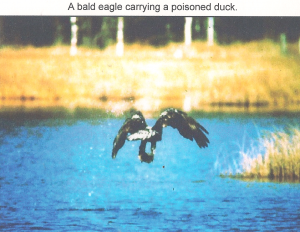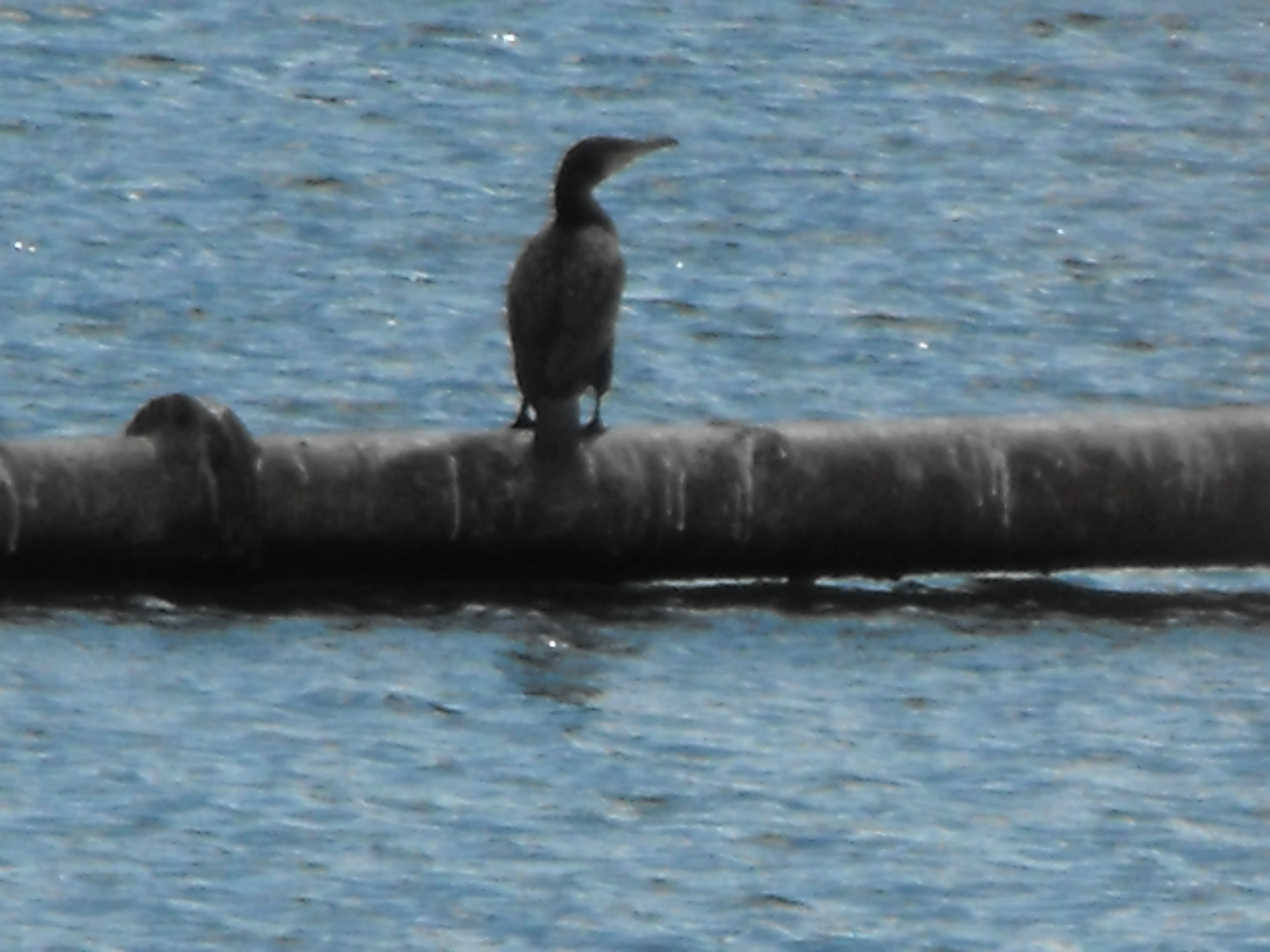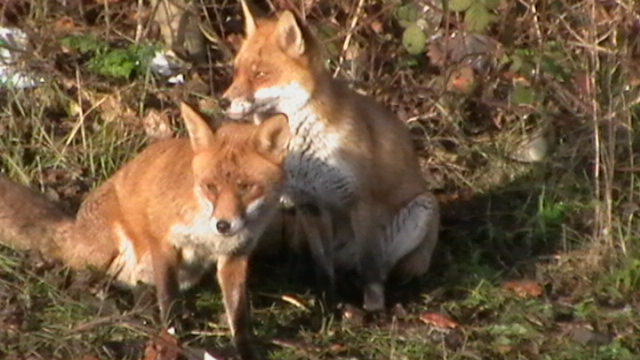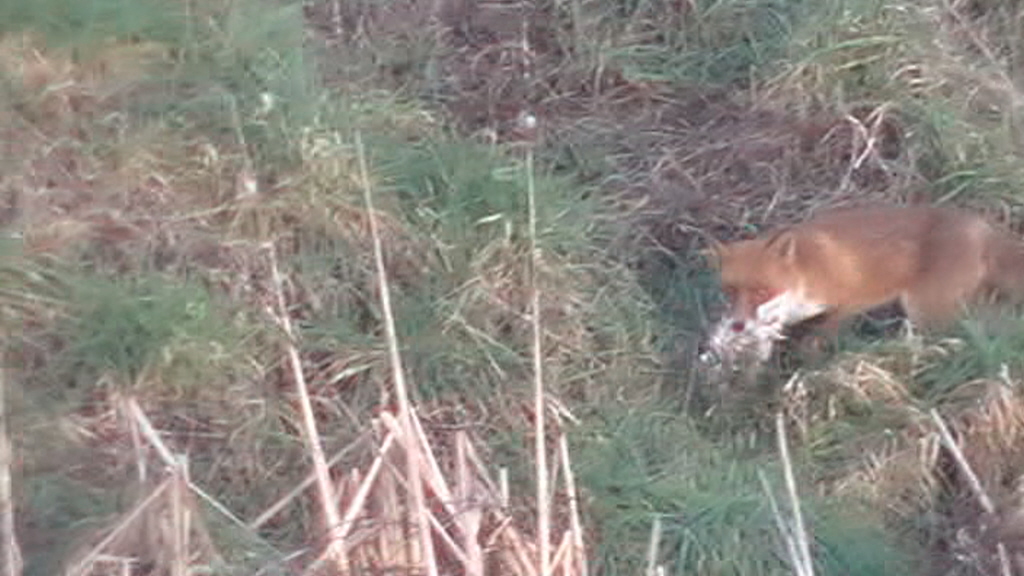
A dead Canada goose on the smaller lagoon at Rattlechain. Other birds have started to eat the remains.
Evidence from Eagle River flats in Alaska confirms secondary poisoning in bald eagles, dying after ingesting dead birds. (Predation of Ducks poisoned by white phosphorus: exposure and risk to predators (1994) By BD Roebuck, S.I Nam, D.L MacMillan, K.J Baumgartner, and M.E Walsh.)
“Abstract
White phosphorus (P4) has been identified as the cause of mortality for dabbling ducks and swans at an estuanne salt marsh in Alaska. Predation of ducks poisoned by P4 was monitored to assess the extent and range of predator exposures to P4. Avian tissues were analyzed for P4 by gas chromatography. We observed that both sick and dead dabbling ducks were common prey of bald eagles (Hahaeetus leucocephalus), herring gulls (Larus argentatus), and common ravens (Corvus corax). Frank signs of P4 intoxication attracted predators and rendered the ducks easy prey. White phosphorus was found in the tissue remains of ducks that had been preyed upon, thus providing positive evidence that predators were exposed to P4. Although P4 varied widely among individuals, P4 was generally highest in the gizzard contents followed by fatty tissues such as fat depots and the skin. White phosphorus was identified in fatty tissues of one eagle and in one herring gull egg, thus providing direct evidence of absorption of P4 by predators.”
These simple steps were illustrated in graphic pictures on The Eagle River Flats website.
Therefore it is entirely plausible that the toxicity of the P4 poisoned meat from dead birds at Rattlechain (which have proven to have been systemically poisoned and found evidence of p4 in the fatty tissues), could prove fatal to predators- given that two of the authors of this report have stated that birds at Eagle River Flats have contained similar amounts of white phosphorus in tissue as those at Rattlechain. There may be no bald eagles at Rattlechain, though the list of predators who could and have fed on dead birds at the lake is considerable. Convulsions shown by white phosphorus poisoned birds, especially large ones like swans would attract foxes to the water’s edge, floundering in the reed beds or causeway path, and with birds more likely to beach themselves incoherently to avoid drowning would also increase predation risk.
Don Sparling* has noted “Several species of raptors including bald eagles, golden eagles, peregrine falcons, and harriers as well as herring gulls and ravens feed on dead and dying waterfowl. These birds, in turn, may be exposed to P4 either by ingesting intact pellets from gizzards or by eating P4-laden tissue. Although P4 is eliminated from living birds within a day or two either by excretion or metabolism, it may linger in the tissues of dead animals for substantially longer periods.”
and also crucially
“Signs of P4 intoxication include ataxia, excessive drinking, loss of appetite, listlessness, rhythmic head movements and convulsions. The listlessness makes intoxicated waterfowl easy prey for several species of raptors inhabiting Eagle River Flats and the convulsions attract predators, thereby increasing the possibility of secondary poisoning to eagles, hawks, ravens, and gulls. “
* “Ecotoxicology of White Phosphorus in an Alaskan Tidal Marsh by
Donald W. Sparling , USGS Patuxent Wildlife Research Center “
Also reported in this study are white phosphorus’ ability to enter eggs of herring gull and also the teratogenic effects* of deformed ducklings of hens dosed with p4,the most serious involving scoliosis, spina bifida, micropthalmia, hydrocephalia, and lordosis .
*Teratogen — A chemical that causes structural defects that affect the development of an organism.
A further study, Secondary poisoning of kestrels by white phosphorus- Sparling, D.W. & Federoff, N.E. Ecotoxicology (1997) 6: 239. notes
“Intoxicated waterfowl attract raptors and gulls that feed on dead or dying birds. To determine if avian predators can be affected by secondary poisoning, we fed American kestrels (Falco sparverius) 10-day-old domestic chickens that had been dosed with white phosphorus. Eight of 15 kestrels fed intact chicks with a pellet of P4 implanted in their crops died within seven days. Three of 15 kestrels fed chicks that had their upper digestive tracts removed to eliminate any pellets of white phosphorus also died.
…..White phosphorus residues were measurable in 87% of the kestrels dying in the study and 20% of the survivors. This study shows that raptors can become intoxicated either by ingesting portions of digestive tracts containing white phosphorus pellets or by consuming tissues of P4-contaminated prey.”
Predator species at Rattlechain include members of the corvid family- carrion crow, magpie and jay.
Raptors include buzzard and kestrel and likely owl species. Cormorants occasionally visit the site between the canal and Sheepwash Local Nature Reserve.
Grey heron and several gull species, including herring gull are also meat eating predators of small birds as well as rodents on the site. Then there are domestic/feral cats. Evidence of dead rabbits have been noted on the site by Rhodia staff themselves, though these were not given a post-mortem.
IT SHOULD ALSO BE NOTED THAT WE HAVE OBSERVED DIRECT EVIDENCE OF HUMAN PREDATED BIRDS AROUND THE AREA WHERE BIRDS COULD HAVE LEFT RATTLECHAIN LAGOON HAVING INGESTED SUBLETHAL AMOUNTS OF P4.















